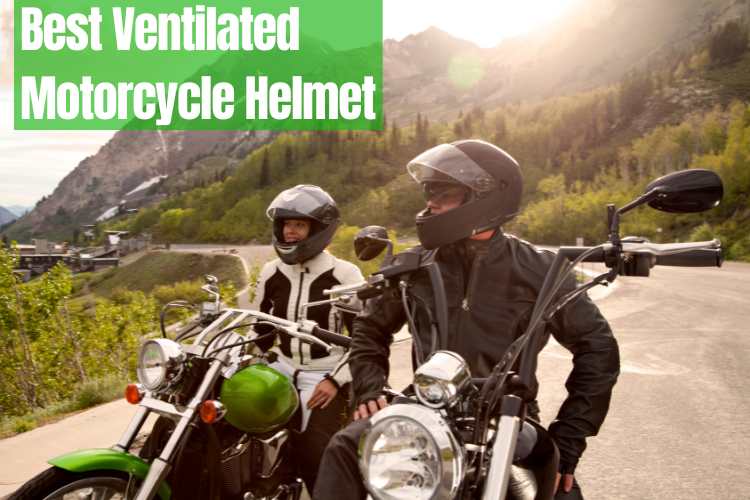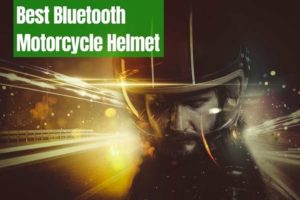With the extreme rise in global warming, summers are hotter and winters are shorter all around the world. No matter how breathable a full-face helmet is or how open a half-helmet is, a rider will almost always be dripping sweat at the end of their journey.
Since heat strokes are a real danger, helmet manufacturers have brought out specially curated ventilated motorcycle helmets! In this guide, we compare 10 of the Best ventilated motorcycle helmet models available plus elaborate on how to choose and use one!
The 10 Best Ventilated Motorcycle Helmets
1. Shoei X-14 Marquez Black Concept 2 Helmet
Premium Choice – The most Lightweight
Engineered for speed road runners, the Shoei X-14 Marquez Black Concept 2 Helmet is an aggressive full-face structure. It’s made with high-quality fiber materials and organic elasticated fibers to maximize structural integrity and durability while maintaining a steady weight of just three pounds.
With the helmet on, it almost feels like you’re wearing air on the head and it’s not just because of its lightweight. The X-14 has a powerful ventilation system consisting of an upper air intake vent and a top outlet vent neatly positioned for maximum airflow.
Nestled between the vents and the outer shell is the soft interior. Along with a multi-density shock-absorbing EPS liner, the Shoei helmet features a 3D Max-Dry interior which can be removed fully to wash and dry.
Cheek pads are vented using a proprietary Cooling System that blows air through tiny holes to clear away humidity and musty smells. They can also be adjusted to have a better field of vision without shifting the helmet’s position.
The entire lining of the Black Concept 2 helmet is moisture-wicking. In fact, it dissipates sweat twice as fast as the industry’s standard rate. This keeps the head and body cool.
Lastly, Shoei X-14 comes with a removable breath guard, a chin curtain, and an Emergency Quick Release System to seal everything in perfectly.
Our Take:
The Shoei X-14 Marquez Black Concept 2 Helmet is the perfect collection for seasoned motorcyclists looking to treat themselves this summer.
2. Arai Signet-X Helmet
Editors’ Choice – Most Impact Protective
Designed for extreme action, the Arai Signet-X helmet is a premium full-face shell constructed using proprietary techniques and tools. The formula is named Peripherally Belted-Super Complex Laminate Construction or PB-SCLC for short.
Basically, it packs impact protection, abrasion resistance, and crash safety into an affordable piece so nobody has to compromise their safety. Evolved from the company’s best-selling helmet, the Arai Signet-X presents the predecessor’s biggest strength: a high-performance ventilation system.
Only this time, it’s even better! The stylish full-face helmet features massive openings as intake and exhaust ports. All of them are adjustable even with thick winter gloves on. It keeps the head cool in the summer and manages airflow in the winter.
The Arai Signet-X helmet also features a chin curtain that functions to exhaust out negative air pressure also known as wind noise. This way, every ride on the road is silent and steady.
The interior is decked out in removable foam padding that is fully removable and washable. To guarantee full coverage, the full-face shell comes with a VAS-Max Vision visor as well as a Pinlock 120 lens – both of which are anti-fig and easy to operate while racing at speed.
For the first time ever in the Signet series’ history, Arai has introduced Emergency Release Tabs to improve crash safety. That’s not all, cheek pads inside also feature pockets to install speakers!
Our Take:
The Arai Signet-X full-face helmet is one of the best in the market for its proprietary features, maximized comfort, and convenience. If you can splurge, the investment is well worth it.
3. Alpinestars Supertech M10 Carbon Helmet
High-Quality Choice – Most Size-Inclusive
Advertised as the lightest helmet on the public market, the Alpinestars Supertech M10 Carbon full-face helmet is a powerful structure built with carbon fiber: the lightest material available with the most tensile strength. It promises a great shield against impacts and doesn’t dent easily.
The interior is engineered with a soft shock-absorbing hydrophobic liner, a soft EPP foam to protect the collarbone, and a proprietary ventilation system featuring a total of 19 intake ports and 5 exhaust vents. It projects maximum airflow during the summer and protects the head from overheating.
The best feature of the Astars M10 helmet is its custom A-head system that allows the rider to adjust the fit of the helmet in a personalized manner. Maximizing the versatility, the DOT-approved helmet comes with two overhead peaks and an E-ject system for emergency snap-offs.
Our Take:
The Alpinestars Supertech M10 Carbon Helmet is a summer rider’s best pick. Not only is it the lightest pick of the lot, but it’s also one of the best full-face, airflow motorcycle helmet at this price.
4. Simpson Mod Bandit Helmet
Our Top Pick – Most Comfortable
Outfitted with the best shells in the market, the Simpson Mod Bandit full-face helmet comes built with a lightweight composite shell and stitched with a multi-density EPS foam liner. It factors in impact protection along with the comfort of the rider.
Speaking of comfort, roadrunners of the summertime will appreciate the extensive ventilation of the Simpson Mod Bandit. It features intake ports at the top, exhaust vents at the back, dual adjustable vents at the chin as well as a removable moisture-resistant liner inside.
With the helmet secured under the chin, and the peaks propped up to shield the eyes against the sun, every ride will be easy and breezy on the highway.
Our Take:
Along with offering exceptional ventilation, the Simpson Mod Bandit Helmet is also aerodynamically tuned which is a win-win deal for racers and motocross madmen – an excellent summer motorcycle helmet.
5. Schuberth C3 Pro Helmet
Reliable Choice – Best Wind Noise Reduction
A name brand among many expert motorcyclists, Schuberth introduced its C3 Pro full face helmet and it quickly became a fan-favorite.
Featuring a composite glass fiber shell with hints of resin, the Schuberth shell is the perfect picture of strength. The interior is nothing short of excellent either. With a multizone EPS foam and an adjustable CoolMax padding system integrated, this shell is ready to wear all year round.
Along with the heat-dissipating pads, the C3 Pro helmet comes with variable venting where air circulates through multiple channels and cools down the head 60% faster as it gets hotter.
To maintain proper security, the aerodynamically tuned Schuberth helmet is fitted with a proprietary Anti-Roll Off system so riders can speed without worrying about the helmet falling off or wind drag slowing the bike down.
The best part is that there’s little to no wind noise when wearing the helmet. It’s designed to reduce the sound of the wind and surrounding noises to improve the comfort of the rider.
Our Take:
The Schuberth C3 Pro helmet is a low-profile positioned speeder’s best find, especially in the summer. It fits great, has great airflow, and is the quietest helmet on the market.
6. Icon Airframe Pro Koi Helmet
Stylish Choice – Most Durable
Built for interaction, the Icon Airframe Pro Koi full-face helmet comes with a colorful shell crafted by hand using high-quality composite materials. Because it’s man-made, the helmet actually has an improved shell design that levels up aerodynamics, promotes speed, and reduces wind drag.
Sealed in with a rapid-release system, the interior is stitched with moisture-wicking liners that cool down the head with the help of nine intake ports, five exhaust ports, angled forehead vents, and chin vents to target the airflow at the most heated areas.
Our Take:
The Icon Airframe Pro Koi Helmet is a wonderful addition to an enduro rider’s gear. It offers great bang for the buck and promises maximum benefits that are certified globally. Not to mention, it’s quite fun to look at!\
7. LS2 Valiant II Blackout Modular Helmet
Reviewer’s Choice – Most Aerodynamic
After the massive hit, the Valiant was, LS2 launched the Valiant II Blackout Helmet which features a modular shell built with Kinetic Polymer Alloy, a distinctly sturdy material that can withstand high temperatures and harsh hits.
The outperforming modular shell comes with a slimmer chin bar which improves the aerodynamics of the helmet, reduces the wind drag, and inspires confidence in the rider.
While seated in a low-profile position, stuffed in a modular shell, the drop-down sun shield of the Valiant II protects the eyes from harsh UV rays and a superior ventilation system brings in cool air and releases the musty smells.
Our Take:
The LS2 Valiant II Blackout Helmet is a popular modular helmet, crafted to perfection and presented in a well-deserving price tag – perfect for competitive racers and dual sport riders.
8. Bell Qualifier DLX MIPS Helmet
Beginners Choice – Most Feature Fed
A household name for decades, Bell launched their Qualifier DLX MIPS helmet and every novice motorcyclist made a run to grab it. It’s just that good!
Crafted using a lightweight polycarbonate shell, the Bell Qualifier provides excellent crash safety and protection against harsh impacts. It’s also incredibly durable under extreme temperatures.
To maximize the structural integrity of the helmet, MIPS was integrated so no shock or rotational forces can leave a dent on the helmet – let alone the rider’s head.
A full-fledged padded interior absorbs the shock, keeps a secure fit, and provides comfort to the rider. The cheek and top pads are removable, washable, and anti-microbial so no matter how long you’re stuffed in the helmet, it won’t adversely affect the skin.
On the topic of feeling stuffy, the Bell Qualifier DLX helmet comes with adjustable vents at the top and back to provide maximum airflow and keep the humidity levels low.
Not to mention, it comes with a transition face shield that darkens under the sun and lightens up at night!
Our Take:
The Bell Qualifier DLX MIPS helmet is a one-of-a-kind pick for beginners. It’s durable, breathable, flexible, and best of all, it comes with a five-year warranty! If that’s not great value for money, we wouldn’t know what is.
9. Shark Street Drak Helmet
Retro Choice – Best for Urban Riders
The best gift to city riders, the Shark Street Drak full-face helmet is outfitted with a thermoplastic resin shell that is injection-molded for extreme impact protection and lightweight durability.
The interior is made of natural fiber which not only soothes the skin on long rides, it also cools down the temperature inside so it doesn’t feel as stuffy having the helmet on.
Supporting the cooling mechanism, the Shark Drak helmet has a great ventilation system characterized by vents at the top, and back, and a few diffusers to clear up the fog. The performance is quite breathable and can be adjusted to target the airflow to specific heat zones.
Great news for goggle wearers, the Shark Drak helmet promotes inclusivity by not only providing space to fit in prescription glasses but also giving an anti-scratch sun visor with a wide lens view.
Our Take:
The Shark Street Drak Helmet checks off all the boxes for a basic helmet with the best features and great looks.
10. AFX FX-41 DS Helmet
Value Choice – Best Optics
Designed for dual sport riders, the AFX FX-41 DS helmet is constructed using an advanced lightweight composite poly-alloy shell that makes riding in a low-profile position a breeze with its impact protection.
Along with a drop-down internal sun visor that shields the eyes from harsh UV rays and a hypoallergenic cooling liner, the helmet comes packed with a whopping 17 vents situated all around the shell to create a multi-path channel of airflow.
The proprietary face shield is the FX-41 DS helmet’s best feature. It provides a wide-angle peripheral view, has a quick-release mechanism for emergencies, is scratch-resistant, and has room to place goggles in.
Our Take:
The AFX FX-41 DS helmet is great if you’re looking for a reliable shell with great ventilation, field of vision, and durability with an affordable price tag and a lifetime warranty.
What’s the Difference Between a Ventilated Helmet and an Aerodynamic Helmet?
Most motorcyclists get confused between the two but simply put, ventilation maintains the airflow inside the helmet while an aerodynamic shell handles the wind outside.
To elaborate, ventilation is a system designed to keep the head cool and relieve the shell off humidity – especially if it’s full coverage. It functions using intake and exhaust ports which bring in cool air to circulate all over the head and then release the warm, humid air from the back, respectively. It also functions to clear up fog from the visor.
Aerodynamics, on the other hand, are designed to reduce wind drag on the helmet which basically, refers to the pull-back felt while riding at high speeds on the road. It is tuned by crafting a streamline-shaped shell and a slimmer chin bar.
Ventilation is important for every rider, no matter the position they’re riding in and the distance they’re covering. It’s especially needed during the summer months to prevent heat exhaustion.
On the contrary, aerodynamics isn’t a priority for everyone. Reducing wind drag increases the speed and performance of the rider so having an aerodynamic helmet is best for competitive racers, ADV tourists, and motocross riders that sit in a low-profile position.
What Do Motorcycle Helmet Vents Do?
There are vents present on every helmet so why do we need special helmets for ventilation? It’s because vents perform a lot more functions than air circulation and some helmets do not tick off all the boxes. Let’s deep dive into what a simple intake and exhaust port can do:
Cooling
The main function of a vent is to keep the head cool. This is done by circulating air through the front and top of the head and taking it out the back of the helmet. Since helmets are fitted quite snugly on the head, the head can get overheated really quickly, especially while riding under the sun.
Sweat droplets in the eyes compromise vision and can lead to harsh impacts. This is why it’s important to have vents present near the chin, top of the head, and rear. The cooler the head is, the more comfortable the ride is going to be. Make sure not to overlook this factor even if you’re a city cruiser or a short-distance rider.
Fog-Free
The next best thing about having vents in a helmet is that they keep the visor from fogging up. Whether it’s winter or summer, simply breathing with the visor closed can compromise the field of vision.
This not only disturbs the rider but also makes the journey quite unsafe at high speeds. Air circulating through the vents (especially from the chin and forehead) clears up the fog. This makes riding long distances more efficient and safer.
Easy Breathing
Last on the list of benefits is breathability. With vents clearing up the fog and cooling down the head, it keeps the rider from suffocating. Since helmets are built with hard shells and filled with padding on the inside, it can get a little musty and hard to breathe sometimes.
Constant circulation of air through the vents allows oxygen to pass in and the musty air to leave through the back which allows the rider to breathe easily even if they have the visor down.
This is especially important for crash safety. In case you fall and faint, the vents will keep your head cool and breathing in check long enough for the emergency responders to take charge.
What Motorcycle Helmet Has the Best Ventilation?
Among all the ventilated helmets, there are four types of shells designed: open face, half face, full face, and modular helmet. Because of their unique construction, each helmet performs differently when it comes to ventilation – one of them doesn’t even need intake and exhaust ports! Here’s a detailed look at each type of helmet:
Open Face Motorcycle Helmets
One of the simplest forms of helmet designs, an open-face motorcycle helmet comes with an outer shell to protect the head and no chin bar. Since the bottom of the face is exposed, it is considered less safe to use at high speeds however, that is what makes it extra ventilated.
Wind coming in from the front cools down the face and keeps the sweat from dropping into the eyes. Some open-face helmets do have a couple of vents present on the top of the head as a precaution against overheating.
Full Face Motorcycle Helmets
The safest type of helmet design, a full-face motorcycle helmet covers every part of the face down to the neck and chin. Because it leaves no skin exposed, it can get stuffy inside so there are multiple vents present around the chin, forehead, top, and back of the head.
This way the visor doesn’t fog up, the head is cooled down and the padding doesn’t have a lot of sweat build up. Most full-face helmets are lined with mesh for better breathability and have washable padding to keep hygiene in check.
Modular Helmets
A mixed model of an open-face and a full-face helmet, a modular helmet fully covers the face but has the option to remove the chin bar. Apart from the vents integrated around the helmet, removing the chin bar significantly improves breathability.
These are especially helpful for mountain bike riders. Riding uphill is easier with the chin bar removed as it reduces the weight on the head, improves ventilation, and allows the rider to take deep breaths easily.
The only downside is that modular helmets can be expensive so they are usually shopped by seasoned motorcyclists.
Half Face Motorcycle Helmets
Designed like an open-face motorcycle helmet, a half-face motorcycle helmet also covers the top of the head only. The only difference is, along with the chin, there’s no protection for the ears. It sits on top of the head and is usually used by bike riders instead of motorcyclists because of the difference in speed.
Half-face motorcycle helmets have exceptional ventilation and most of it comes in naturally from the wind coursing through the face and head. Some may have intake and exhaust ports on offer but they are mainly small holes to improve cooling and comfort.
What to Look For to Find the Best Ventilated Motorcycle Helmet?
Now that you know the difference between an aerodynamic helmet and a ventilated one, the functions and features of vents in different helmets; it’s time to narrow down a ventilated motorcycle helmet that meets your needs. Here are all the factors you need to consider while shopping:
Number of Vents
No matter the type of helmet you choose, always make sure it has a good number of intake and exhaust ports. Except for half helmets, all shells need a certain system for air circulation to keep the head from overheating.
In an open-face helmet, this may be an exception as vents are usually just holes, and having a lot of them can leave the head exposed to harm and UV heat.
In other shell designs, vents are integrated into the padding so make sure they aren’t covered by extra layers and the air has enough room to pass.
Don’t worry, having a lot of vents in a motorcycle helmet does not necessarily increase the wind noise.
Position of Vents
Along with how many vents there are on the helmet, look at where the vents are situated inside.
For a full-face and modular helmet, make sure there’s a chin vent or a forehead vent to clear up the fog, vents at the top and sides of the head to reduce the stuffy feeling, and at the back to let the heated air out. For ¾ or open-face helmets, you’ll ideally need intake vents at the forehead, top, and near the ears with the exhaust ports at the rear.
This way air circulates all over the face and around the head towards the back, consistently relieving any suffocation you might feel, and making every ride a literal breeze.
Adjustability
If, in case, your choice of motorcycle helmet does not have a lot of intake vents present, no worries. Some modern launches come with adjustable vents that allow the rider to target the flow of air where they want.
This is a nice workaround for high-speed riders like mountain bike riders and motocross madmen who need extra impact protection more than ventilation.
Plus, having adjustable vents helps a lot during the winter. You could close the ones around the ears for extra warmth or keep the chin vents open for a fog-free ride.
Inner Lining
Every motorcycle helmet comes with an interior decked out in foam layers, padding and lining. They are mainly present to absorb shock during an impact but they do significantly affect the temperature regulation of a helmet.
If you live in a hotter climate, look for helmets with a mesh liner as they are more breathable. In the winter, add extra padding around the ears and neck only. This way you’ll close any gaps where air could flow which levels up the warmth without compromising the ventilation.
Hygiene
Whether it’s summer or winter, the head can heat up – either from the sweat or the foggy condensation. Over time, it can build up and wear out the padding faster.
To maintain the health of the helmet and the head, make sure the inner liner and padding you choose are moisture-wicking. So, when the body naturally cools down by sweating, the heat can be evaporated easily.
To keep hygiene in check, most helmets come with padding that is removable and washable. This, also, clears up the sweat and dust build-up leading to a more breathable ride.
Face Shield
Lastly, choose a motorcycle helmet with a good face shield or visor. It may come off as an additional feature, however, having the right visor can support the cooling mechanism of the vents.
For instance, a drop-down sun visor or a dark lens shields the eyes from the harsh UV rays which also keeps the face cool. If the visor fogs up, the vents should clear it right away.
If you’re going for a half helmet, make sure it has a peak overhead to keep the sun away.
Frequently Asked Questions
Is there such a thing as an air-conditioned helmet?
Yes, there aren’t many but the world’s first air-conditioned helmet is the Feher ACH-1. It is a full-face helmet that comes with a self-contained air conditioner along with other basic features. The AC helmet is quite expensive but reviewers report the investment is worth it.
Are ventilated motorcycle helmets important in the winter?
Yes, ventilated motorcycle helmets are important in the winter. Although it brings in cold air, it also keeps the visor from fogging up and releases musty air through the exhaust ports.
Vents in a helmet keep the rider from suffocating, especially in a full-face helmet. Wear an ear muffler and the wind won’t bite.
Do vents increase wind noise in a motorcycle helmet?
No, vents do not increase wind noise in a motorcycle helmet. It’s the lack of padding and gaps between the neck and base of the helmet that increases the noise levels. Simply add a layer of padding or a neck roll to reduce the amount of air flowing inside and ultimately, the wind noise.
Is a ventilated helmet also aerodynamic?
No, a ventilated helmet isn’t necessarily also aerodynamic. Ventilation of a helmet is performed by intake and exhaust ports situated around the outer shell whereas the shape of the outer shell decides how aerodynamic or wind-resistant the helmet is. Simply put, ventilation makes a ride breathable while aerodynamics reduces wind drag to improve speed.
What is a modular helmet?
Modular helmets come with a chin guard that you can remove or fasten to the rear of the shell. They’re usually more comfortable and help you widen your field of vision. The chin guard can be easily raised in some models, known as flip-ups.
Final Thoughts
The best-ventilated motorcycle helmets are just a choice away, now that you’ve figured out what to look for and had an overview of the top-ranking helmets available!














